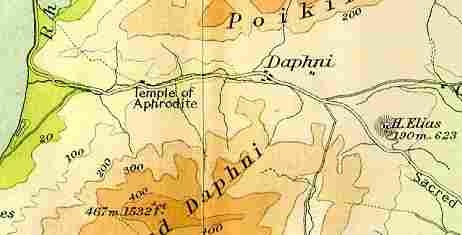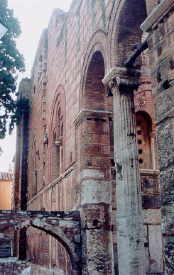

 On the way to Eleusis or points West, you are sure to see
signs noting the presence of the Monastery of Daphni. But you will not
see street signs alone, there are more easily recognizable, and far larger
indicators that a tourist attraction is nearby. Countless tour buses
frequent the church each day and it is all the more desirable to packaged
tours given its location on the outskirts of Athens. Nevertheless, it
is still an agreeable stop if you arrive at opening time and beat the tourist
hordes. The Monastery
of Daphni
was designated as an official World Heritage Site by UNESCO in 1980.
On the way to Eleusis or points West, you are sure to see
signs noting the presence of the Monastery of Daphni. But you will not
see street signs alone, there are more easily recognizable, and far larger
indicators that a tourist attraction is nearby. Countless tour buses
frequent the church each day and it is all the more desirable to packaged
tours given its location on the outskirts of Athens. Nevertheless, it
is still an agreeable stop if you arrive at opening time and beat the tourist
hordes. The Monastery
of Daphni
was designated as an official World Heritage Site by UNESCO in 1980.
The site was originally a Sanctuary
of Apollo, whose sacred laurel trees (daphnai) gave the convent its name.
It was mentioned by Pausanias who passed by it while he was moving along
the Sacred Way.  The sanctuary was destroyed around 395 A.D. and the materials from the temple
and other buildings were reused in the construction of the monastery, which
was started in the 5th or 6th century A.D. This at least has preserved
many fragments visible today in almost all parts of the church. The
one thing visitors come to see most though are the mosaics. There
are a number of mosaics inside the monastery which survive in beautiful condition
from the 11th century. Though I do not have any photos of these, you
can see a few online at the Ministry of Culture's web site (available below).
The sanctuary was destroyed around 395 A.D. and the materials from the temple
and other buildings were reused in the construction of the monastery, which
was started in the 5th or 6th century A.D. This at least has preserved
many fragments visible today in almost all parts of the church. The
one thing visitors come to see most though are the mosaics. There
are a number of mosaics inside the monastery which survive in beautiful condition
from the 11th century. Though I do not have any photos of these, you
can see a few online at the Ministry of Culture's web site (available below).
The Site Today
Located a few meters away from an extremely
busy highway, the monastery is not as quiet today as it must have been in
Pausanias' time. The enceinte keeps the view agreeable from the inside
though and the planting of numerous trees and shrubs around the exterior have
kept the site shady and pleasant. There is a gift shop at the entrance
where the standard "Guide to Byzantine Greece" books are sold as well as
a number of postcards of the mosaics. A thin, glossy tour book of the
site is available for only 1000 drx. ($3 U.S.).
Although I purchased a tour guide to
this site in my latest trip, the Greek postal system decided it would retain
it and it was snatched from my envelope somewhere en route.